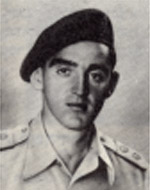Son of Haim and Leah. He was born in Ostrov-Mazowiecki, Poland, on 4 July 1927. He received his first education at the first Hebrew kindergarten in his hometown, and later went to the Tarbut school, (The father – a Zionist activist, the mother – a teacher in a Jewish government school), and at the age of 11 he immigrated with his mother to Israel (the father immigrated two years before them). The family settled in Kfar Yehoshua at the time. Along with his great love for the country and his enthusiastic dreams, the boy also brought with him knowledge in Hebrew; Although he was poor, his strong desire and great energy stood in his adaptations to his studies to the extent that he found no difficulties in them. When the labor companies of the children’s society were organized in the school, he devoted himself to the agricultural work in them; And how Simcha he was about his parents’ decision to send him, after completing his studies at the Kfar Yehoshua school, to an agricultural school. Was the first member of the Histadrut movement that opened that year at Mikveh Israel. During his years there, he did not sever ties with his friends in the village, and when they began to study in the following grades in Jerusalem, he joined his friends after completing his studies at Mikveh and expanded his education there. At an early age, he joined the Haganah and taught many students. In Kfar Yehoshua, he worked in agricultural work, but because of the situation in the Yishuv, he volunteered for the Palmach, where he saw everything, first he belonged to the naval company and the naval course he had attended to prepare seamen for immigration. He was arrested with most of his friends and brought to detention in Atlit and then in Rafah, but after six weeks, when he was released, he continued with great enthusiasm: During the War of Independence he was a member of the Harel Brigade, Aharon Schmidt, who fell on the 19th of Tishrei 5709 – 19.10.1948), later served as a company commander, and his entire career in the army, from then until they fell, is paved with stories of heroism and heroism. He excelled in leadership and courage in the battles for the liberation of Jerusalem. In the Battle of the Radar, he was wounded but did not leave the campaign and continued with his head of staff out of courage – a trait that was in the ranks of our fighters and with which he had gone through all the stages of the War of Independence. At the end of the war he decided not to abandon the ranks of the defenders and fighters and joined the regular army, when he told his family: “There is no choice; In the IDF he saw a national vision and pioneering vocation, and the army was both a life-long and a life-long aspiration for him. Later, he was appointed commander of the arms branch at the infantry school, and was then found to be in the hands of the training problems. In 1950, he was promoted to lieutenant colonel and was Simcha to receive command of a Givati battalion. During his eight years of service in the Israel Defense Forces, he served in various capacities not only out of skill and diligence, but also in devotion and dedication. Although his position as a staff officer served as a focal point during the days of reprisal operations, which were planned in part, he not only immersed himself in preparatory work, But also in executive positions.In the late summer of 1956 he was tasked with establishing an armored brigade, A month and a half before the Sinai Campaign, he was granted the rights to the rank of colonel, but until now the battle has been opened and he has been prevented from completing the transition period until the rank is approved -SignaturesGod. In the Sinai Campaign, on the 27th of Mershvan, 5711 (1/11/1956), he headed the armored brigade, which he founded and nurtured, and in the reading of “After!” Who was fond of him, and who had his tongue in his mouth, went out with his friends and stormed the Abu Agila outposts – the battle from which he did not return. He was meticulous in matters of discipline and punctuality in execution, and with this he walked among his subordinates with candor and practiced them with candor, and in his simple simplicity gained the trust and affection of all those who worked with him. While he was being critically wounded at the hospital in the field, he chanted encouragement to his fellow fighters and asked, “What’s up with the guys?” “What’s going on at the front?” His consciousness was lost and his soul departed. He was buried in the Military Cemetery for Emergency Sitchel, and on the 13th of Marcheshvan 5711 (November 7, 1957) he was transferred to eternal rest in Kfar Yehoshua. His grave was dug in the shade of the trees he planted while he was working in the village. He left a wife and three children. In the collection “Livneinu,” published by Kfar Yehoshua in 1959, he was mentioned in his memory and in his book.
